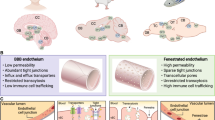Summary
The relationship of free arachidonic acid (AA) to cellular permeability, lipid peroxidation and physical state “fluidity” of the membrane was investigated in cultured endothelial cells (EC) dissociated from cerebral microvessels of rats. The results demonstrate that AA can induce a reversible alteration of endothelial permeability to trypan blue albumin (TBA). Exposure of EC to AA increases membrane “fluidity” as measured by fluorescence anisotropy using 1,6-diphenyl-1,3,5 hexatriene as a fluorescent probe. The AA modification of EC membrane “fluidity” is not associated with changes in EC permeability. Addition of AA and H2O2 to the incubation medium of EC leads to persistant alteration of EC permeability which can be prevented by catalase treatment. Both AA and H2O2 induce a greater formation of malondialdehyde, the product of lipid peroxidation, than AA alone. These findings strongly suggest that a release of AA either from the capillary or cellular membrane of the brain under a pathological condition may alone or through a peroxidative process alter the function of blood-brain barrier.
Similar content being viewed by others
References
Bazan NG, Rodriquez de Turco EB (1980) Membrane lipids in the pathogenesis of brain edema: phospholipids and arachidonic acid, the earliest membrane components changed at the onset of ischemia. Adv Neurol 28:197–205
Boiadjieva S, Hallberg C, Hogstrom M, Busch C (1984) Methods in laboratory investigations. Exclusion of trypan blue from micro-carriers by endothelial cells: an in vitro barrier function test. Lab Invest 50:239–246
Bradford M (1976) A rapid and sensitive method for the quantitation of microgram quantities of protein utilizing the principle of protein-dye binding. Anal Biochem 72:248–254
Buege JA, Aust SD (1978) Microsomal lipid peroxidation. Methods Enzymol 52:302–310
Chan PH, Fishman RA (1984) Phospholipid degradation and the early release of polyunsaturated fatty acids in the evolution of brain edema. In: Go KG, Baethmann A (eds) Recent progress in the study and therapy of brain edema. Plenum Press, New York London, pp 193–202
Chan PH, Fishman RA, Caronna J, Schmidley JW, Prioleau G, Lee J (1983) Induction of brain edema following intracerebral injection of arachidonic acid. Ann Neurol 13:625–632
Dobretsov GE, Borschevskaya TA, Petrov VA, Vladimirov YA (1977) The increase of phospholipid bilayer rigidity after lipid peroxidation. FEBS Lett 84:125–128
Fridovich I (1976) Oxygen radicals, hydrogen peroxide and oxygen toxicity. In: Pryor WA (ed) Free radicals in biology. Academic Press, New York London, pp 239–277
Halliwell B (1987) Oxidants in human disease: some new concepts. FASEB J 1:358–364
Henning B, Chow CK (1988) Lipid peroxidation and endothelial cell injury: implication in atheroscleosis. Free Radical Biol Med 4:99–106
Hennig B, Shasby MD, Fulton AB, Spector AA (1984) Exposure to free fatty acid increases the transfer of albumin across cultured endothelial monolayers. Arteriosclerosis 4:489–497
Katz AM, Messineo FC (1981) Lipid-membrane interactions and the pathogenesis of ischemic damage in the myocardium. Circ Res 48:1–16
Kempski O, Spatz M (1987) Blood-brain barrier: in vitro studies of endothelial permeability. In: Cervos-Navarro J, Ferszt R (eds) Stroke and microcirculation. Raven Press, New York, pp 223–227
Kempski O, Villacara A, Spatz M, Dodson RF, Corn C, Merkel N, Bembry J (1987) Cerebromicrovascular endothelial permeability in-vitro studies. Acta Neuropathol (Berl) 74:329–334
Kogure K, Arai H, Abe K, Nakano M (1985) Free radical damage of the brain following ischemia. Prog Brain Res 63:237–259
Kontos HA (1985) Oxygen radicals in cerebral vascular injury. Circ Res 57:508–516
Lentz BR, Barenholz Y, Thompson TE (1976) Fluorescence depolarization studies of phase transition and fluidity in phospholipid bilayers. Biochemistry 15:4529–4537
Molitoris BA, Kinne R (1987) Ischemia induces surface membrane dysfunction, mechanism of altered Na+-dependent glucose transport. J Clin Invest 80:644–654
McCord JM (1987) Oxygen derived radicals: a link between reperfusion injury and inflammation. Fed Proc 46:2402–2406
Rice-Evans C, Hochstein P (1981) Alterations in erythrocyte membrane fluidity by phenylhydrazine-induced peroxidation of lipids. Biochem Biophys Res Commun 100:1537–1542
Shinitzky M, Barenholz Y (1978) Fluidity parameters of lipid regions determined by fluorescence polarization. Biochim Biophys Acta 515:367–394
Spatz M, Bembry J, Dodson RF, Hervonen H, Murray MR (1980) Endothelial cell cultures derived from isolated cerebral microvessels. Brain Res 191:577–582
Stubbs ChD, Smith AD (1984) The modification of mammalian membrane polyunsaturated fatty acid composition in relation to membrane fluidity and function. Biochim Biophys Acta 779:89–137
Unterberg A, Wahl M, Hammersen F, Baethmann A (1987) Permeability and vasomotor response of cerebral vessels during exposure to arachidonic acid. Acta Neuropathol (Berl) 73:209–219
Van Blitterswijk WJ, Van Hoevan RP, Van der Meer BW (1981) Lipid structural order parameters (reciprocal of fluidity) in biomembranes derived from steady state fluorescent measurements. Biochim Biophys Acta 644:323–332
Yamamoto Y, Shima T, Uozumi T, Sogabe T, Yamada K, Kawasaki T (1983) A possible role of lipid peroxidation in cellular damages caused by cerebral ischemia and the protective effect of α-tocopherol administration. Stroke 14:977–982
Yoshida S, Inoh S, Asano T, Sano K, Kubota M, Shimazaki H, Ueta N (1980) Effect of transient ischemia on free fatty acids and phospholipids in the gerbil brain. J Neurosurg 53:323–331
Author information
Authors and Affiliations
Rights and permissions
About this article
Cite this article
Villacara, A., Spatz, M., Dodson, R.F. et al. Effect of arachidonic acid on cultured cerebromicrovascular endothelium: permeability, lipid peroxidation and membrane “fluidity”. Acta Neuropathol 78, 310–316 (1989). https://doi.org/10.1007/BF00687761
Received:
Revised:
Accepted:
Issue Date:
DOI: https://doi.org/10.1007/BF00687761




